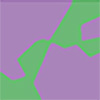| Aug 05, 2025 |
A new imaging technique uses circularly polarised light to visualise chiral structures, improving analysis of biological samples, materials, and active substances.
(Nanowerk News) Why do spearmint and caraway seeds smell so differently, although their main scent molecules are almost identical? Why can a medicine save lives, while its mirror image is ineffective or even harmful? The answer lies in chirality, the “handedness” of molecules. Just as the left and right hands are similar but cannot be placed on top of each other, there are left and right versions of many molecules. These often have completely different effects.
|
|
A research team at ETH Zurich led by Romain Quidant, Professor of Nanophotonics, has developed a method that makes it possible to visualise chirality spatially using just a single image. Until now, chirality has mostly only been able to be measured across the entire sample, and the result has always been an average value.
|
|
“With this new method, we can use a single image to identify the areas of our sample where left-handed and right-handed structures occur,” explains Rebecca Büchner, a doctoral student working under Quidant and lead author of the study published in the journal Nature Photonics (“Wide-field spectroscopic imaging of optical activity”).
|
 |
| The top row shows the design of the sample (green = left-handed sample, purple = right-handed sample). The second row shows the corresponding snapshots taken by the researchers, while the bottom row shows the calculated proportions of left-handed and right-handed samples. Until now, it has not been possible to display the exact distribution in a single image. (Illustration: Rebecca Büchner, ETH Zurich)
|
Light as the key to handedness
|
|
For the study, Büchner used specially manufactured gold nanostructures, i.e. artificially produced chiral samples, which were fabricated by Jose García-Guirado, lab manager in Quidant’s group. Büchner therefore knew how many right-handed and left-handed components to expect in the image. To make the chirality of the samples visible, she used a newly developed imaging method that works like a highly specialised camera. What sets it apart is its ability to detect how the sample interacts with different types of circularly polarised light.
|
|
Circularly polarised light is a type of light where the light waves rotate in a spiral as they move, either to the left or the right. Many chiral molecules in nature react differently to these types of light: they absorb left-handed light more than right-handed light or rotate their direction of oscillation slightly, for example.
|
|
Unlike traditional methods that need two separate measurements with left- and right-circular polarisation, Büchner’s system captures both spiral directions at once. It uses a clever optical setup: after passing through the sample, the light is split into left- and right-circular components using reference beams that create interference patterns. These patterns reveal how each type of light interacted with the sample, making chirality visible.
|
|
A normal camera would capture only an illegible image from this superimposition. Thanks to the new method, however, a computer can read the information accurately. The resulting colour-coded maps show which parts of the sample are left-handed and which are right-handed. “We were even able to visualise letters such as ‘L’ and ‘R’, which were made up of nanostructures with different handedness,” reports Büchner.
|
Opportunities for biology and materials science
|
|
“I see the greatest potential for our method wherever chirality varies spatially, which has been virtually impossible to measure until now,” says Jaime Ortega Arroyo, senior scientist and co-supervisor of the project. This is a well-known problem, particularly in materials science: chiral materials are difficult to resolve spatially, such as when different zones in a material have different handedness. The new method now makes it possible to visualise these differences directly.
|
|
The researchers also see potential for biological samples. For example, healthy and diseased tissue might differ not only in their cell structure but also in their chirality. With the imaging approach, it would be possible to detect such differences directly in the tissue without staining or mechanical intervention. “This applies not only to molecules but also to larger structures such as parts of cells, whose chirality has hardly been studied to date,” explains Büchner.
|
There is also potential for applications in pharmacy: many drugs consist of chiral molecules, only one variant of which is effective. A method that reveals handedness could help to better analyse complex mixtures or develop new diagnostic procedures.
Final touches in the laboratory
|
|
The new imaging method is still in the research stage, and the signals measured so far are moderate and noise-sensitive. “Our biggest challenge was to reduce the noise and signals coming from artefacts in the image to such an extent that we could be sure that the signals actually originated from chirality,” says Ortega Arroyo.
|
|
As a next step, the researchers want to make the system more sensitive. They still have a long way to go before it can be used in the real world. For now, the focus is on identifying suitable applications and adapting the method accordingly. “We know what our platform can do, but other researchers know much better what other use cases could best be investigated with it,” says Büchner.
|


